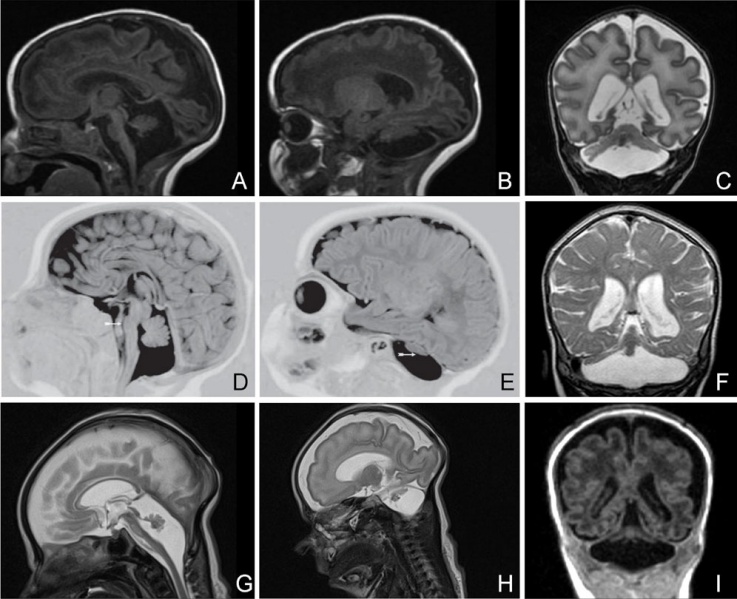File:Pontocerebellar Hypoplasia MRI01.jpg

Original file (996 × 810 pixels, file size: 125 KB, MIME type: image/jpeg)
Pontocerebellar Hypoplasia
MRI sections of cases with PCH type 1, type 2 and type 4. The images of the PCH1 case were kindly provided by Professor Darin, The Queen Silvia. Children's Hospital, Gothenburg University, Sweden. 1A-C: Images of a 2 wk old neonate with PCH1.
- 1A - Mid-sagittal section (T1) shows vermal hypoplasia and marked cerebellar hypoplasia.
- 1B - Lateral sagittal section (T1) shows severe hypoplasia of the cerebellar hemispheres.
- 1C - Coronal section (T2) shows flattened cerebellar hemispheres which also display some atrophy. The vermis is relatively spared.
- 1D-E - Images of a 2 months old baby with PCH2. 1D: Mid-sagittal section (T1IR) shows a flat ventral pons and vermal hypoplasia.
- 1E - Lateral sagittal section (T1IR) shows severely hypoplastic cerebellar hemispheres (arrow) leaving most of the posterior fossa empty.
- 1F - Coronal section (T2) of a 9 months old infant with PCH2 shows flat cerebellar hemispheres and mild vermal hypoplasia (dragonfly configuration). Cerebral cortical atrophy is also present.
- 1G-I - Images of a 31+5 weeks neonate with PCH4. 1G: Mid-sagittal section (T2) shows severe vermal hypoplasia and ventral pontine flattening.
- 1H - Lateral sagittal section (T2) shows severe hypoplasia of the cerebellar hemispheres. Above the tentorium there is an increased distance between the cortical surface and the skull visible, which is probably due to diminished brain growth in utero.
- 1I - Coronal section (T1) shows extremely small and flattened cerebellar hemispheres and severe vermal hypoplasia. Immaturity of cerebral cortex and enlarged ventricles are also visible.
Reference
Namavar Y, Barth PG, Poll-The BT & Baas F. (2011). Classification, diagnosis and potential mechanisms in pontocerebellar hypoplasia. Orphanet J Rare Dis , 6, 50. PMID: 21749694 DOI.
Copyright
© 2011 Namavar et al; licensee BioMed Central Ltd. This is an Open Access article distributed under the terms of the Creative Commons Attribution License (http://creativecommons.org/licenses/by/2.0), which permits unrestricted use, distribution, and reproduction in any medium, provided the original work is properly cited.
Figure 1.
Cite this page: Hill, M.A. (2024, April 27) Embryology Pontocerebellar Hypoplasia MRI01.jpg. Retrieved from https://embryology.med.unsw.edu.au/embryology/index.php/File:Pontocerebellar_Hypoplasia_MRI01.jpg
- © Dr Mark Hill 2024, UNSW Embryology ISBN: 978 0 7334 2609 4 - UNSW CRICOS Provider Code No. 00098G
File history
Click on a date/time to view the file as it appeared at that time.
| Date/Time | Thumbnail | Dimensions | User | Comment | |
|---|---|---|---|---|---|
| current | 12:32, 8 December 2012 |  | 996 × 810 (125 KB) | Z8600021 (talk | contribs) | ==Pontocerebellar Hypoplasia== MRI sections of cases with PCH type 1, type 2 and type 4. The images of the PCH1 case were kindly provided by Professor Darin, The Queen Silvia. Children's Hospital, Gothenburg University, Sweden. 1A-C: Images of a 2 wk old |
You cannot overwrite this file.
File usage
The following page uses this file: